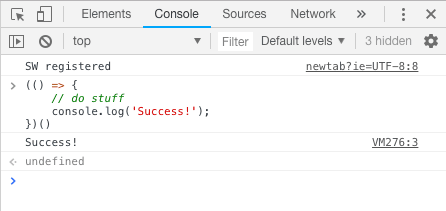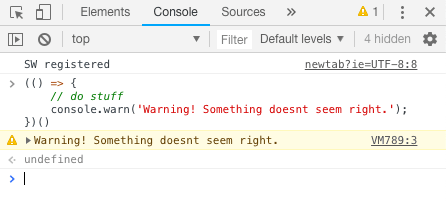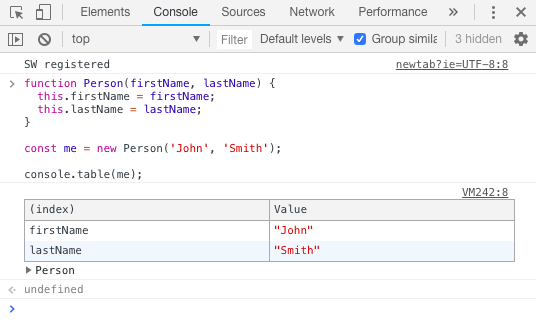If you work with javascript a lot, you probably often need to use console.log() to output some info as you go along.
It's usually just the plain old way though:
(() => {
// do stuff
console.log('Success!')
})()
Here are a few ways you could make your logs a bit more visually informative, and interesting 🙂
Use console.error() for error logs
(() => {
// do stuff
console.error('Oops, something went wrong!')
})()
Use console.warn() for warning logs
(() => {
// do stuff
console.warn('Warning! Something doesnt seem right.')
})()
[Edit] Use console.table() for iterable objects
Thanks to @shoupn
and @squgeim
for pointing this out in the comments :)
function Person(firstName, lastName) {
this.firstName = firstName
this.lastName = lastName
}
const me = new Person('John', 'Smith')
console.table(me)
Add your custom styles
(() => {
// do stuff
console.log('%c%s',
'color: green; background: yellow; font-size: 24px;','Success!')
})()
You can have a custom function in your code that lets you use "your own" log with colors directly
function customLog(message, color='black') {
switch (color) {
case 'success':
color = 'Green'
break
case 'info':
color = 'Blue'
break;
case 'error':
color = 'Red'
break;
case 'warning':
color = 'Orange'
break;
default:
color = color
}
console.log(`%c${message}`, `color:${color}`)
}
customLog('Hello World!')
customLog('Success!', 'success')
customLog('Error!', 'error')
customLog('Warning!', 'warning')
customLog('Info...', 'info')
Here's the pen.
Hope you found this useful and happy debugging! 😊













Latest comments (42)
It was useful. Good job.
I've published a tiny package about this topic.
npmjs.com/package/havecoolconsole
I've authored "console colors", a tiny package which allows easy fun coloring:
github.com/yairEO/console-colors
Is it possible to console.log within a width, so for example the entire width of the console?
Absolutely yes.
Just set display: block; & width: 100vw;
console.log('%c%s', 'display:block;width:100vw;background-color:#cff1de;color:green;font-size:25px','Hello Console!');
As a temporary measure for writing quicker
console.log()'s just put the following in a temporary file (for polluting the global namespace) and link it to the top of your web application then unlink it when no longer needed:Now you can easily do...
This is especially useful when logging multiple test cases in a single run. Similarly can be done with the other console methods. And if you really want to go crazy, this can also be done with
Object.prototype.methodsbut you must often bind the function to the calling object's scope by setting the context withFunction.prototype.bindorFunction.prototype.call. I think ES5 and ES6 have madeFunction.prototype.applyobsolete so I don't use it or recommend it anymore. But only do this on very small projects or inside created objects.Do not forget "console.group"!
enriquemorenotent.com/post/differe...
Short, simple and easy! Thanks!
That's great - I didn't know about
console.table. That's some very cool web-fu.BUT!
Remember - all this debugging is as nothing to the power of good automated tests. A debug line should be ephemeral - an automated test is for life!
@itsmanojb something we were talking about the other day, what was that video you shared?
That was from Angular firebase. Here the full video youtu.be/Mus_vwhTCq0
Cool! Didn't know about the styling/coloring
Glad you learnt something :)
I'm a big fan of the debug module. For debug logs that you don't remove afterwards it is very nice.
Another nice thing is
console.trace, which also prints out a stack trace where the log is called. Useful if you're trying to debug a function which is being called in several critical areas.I have gone about this via namespacing my debug logs so it assigns a colour based on that namespace.
The namespace here being cache which is mapped against an array of colours using the following code...
This way cache logs are always shown in the same colour allowing you to visually identify them.
Idea: Make this an npm package. Wait for it to become popular enough. Inject code to steal credit cards :)
(There was an article about this a few months ago, luckily it was a joke)
I use console.trace to check the stack calls. I use also console.log({variableName}) to get the variableName in the console..
dope
Glad you liked it @sreubenstone
Nice for adding colors on console. It's better!
Yeah! Hope you'll try it out on your next project :)
It's already done ! I've seen this before, but your article complements this feature.